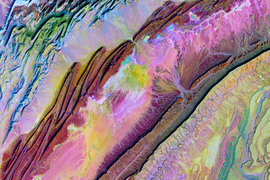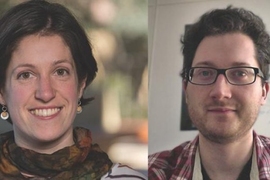On Jan. 1, a magnitude 7.6 earthquake struck the western side of Japan on the Noto Peninsula, killing over 200 people. Japan is prone to earthquakes, including a magnitude 9.1 earthquake in 2011 that triggered a tsunami and killed almost 20,000 people.
William Frank, the Victor P. Starr Career Development Professor in the Department of Earth, Atmospheric and Planetary Sciences at MIT, has been studying an earthquake swarm in the region where the most recent earthquake occurred. He explains the difference between subduction earthquakes and earthquake swarms, and why the unknown nature of these swarms makes predictions hard.
Q: Why is Japan prone to earthquakes?
A: Japan is prone to earthquakes because it is at the western edge of the Pacific plate and a more complicated junction where two plates are subducting, or plunging, beneath the tectonic plate that Japan is sitting on. It's at the interface between those plates where you're going to have a lot of earthquakes, because you're generating stress as the plates move past one another.
But interestingly, this earthquake was not due to subduction. It's on the west coast of the island, and the subduction zones are on the east coast. There are still a lot of active tectonics that are not related to subduction. This one place is enigmatic [as to] why there are so many earthquakes, but there's been this earthquake swarm happening there since 2020. This latest earthquake is the latest big earthquake in the swarm.

Q: What is an earthquake swarm, and how can you tell this earthquake is a part of it?
A: Normally you have the big earthquake, what we call the mainshock, that is followed by a sequence of aftershocks. But in a swarm, there's no clear mainshock because there's a lot of earthquakes before and there's also a lot of earthquakes afterwards. Often there will just be one earthquake that will be bigger than the rest sometime within that swarm duration.
Earthquake swarms are typically around plate boundaries. There's a lot of them in subduction zones but not only [there] — there are also earthquake swarms, for example, in Southern California. These can last days, months, years. We call it a swarm is because it's generating many more earthquakes than we expect from that region, in sustained activity, for the past few years.
Q: How can you tell a swarm from general seismic activity in the region?
A: It's not obvious; it'll take some time before you realize that what's happening now is not what was happening previously. Typically, it's something that ramps up, attains some sort of sustained activity level, and then ramps back down.
Q: Tying it into the 2011 earthquake, which caused significantly more damage, what makes an earthquake more damaging than others?
A: The 2011 earthquake was the subduction of the Pacific plate beneath Japan. In there, you have a lot of fault real estate that can rupture altogether and generate a magnitude 9 earthquake. That earthquake was offshore of Japan, so the shaking was strong, but the biggest damage came from the tsunami. The sudden motion of the seafloor moved the water on top, and that created a big tsunami that then caused its own set of aftereffects and damage to the coast of Japan.
For this earthquake on the Noto Peninsula, because it was beneath the land it's not going to have that sudden uplift of the water on top and feed that tsunami. After the New Year’s Day earthquake, the Japanese authorities initially put out a bunch of tsunami alerts, but then eventually removed them when they realized that we don't expect this to generate the motion necessary for a tsunami. Depending on the tectonic context, a tsunami will likely be generated or not by an earthquake, and that is often the hazard that causes the most amount of damage.
Q: What can these swarms tell us about future activity in the region?
A: Going back to the mainshock/aftershock earthquake sequence, we know that there's going to be an elevated rate [of activity] for the next few days or months, and that these earthquakes are going to happen in the general region of where that big earthquake happened.
For a swarm, because we don't understand it as well, we don't have a clear idea of what's going to happen. Sometimes we've seen swarms that are actually stopped by a big earthquake, and then there's nothing else afterwards — it sort of shuts down the system. Sometimes it's just the biggest earthquake in a long sequence of earthquakes.
Q: You'll often hear people talking about big earthquakes being foreshocks or predictors for bigger earthquakes to come. Do we need to be worried about this being a foreshock?
A: When we are thinking about something along the lines of what you just mentioned, it's because we're thinking about the earthquake budget along a tectonic plate boundary. On a boundary, we know the relative motion and we know that the plates are pretty much rigid, so that all the motion is being accommodated at the interface between the two plates. That gives us some budget for how these plates are going to move over a long period of time.
Let's say, for example, there's a magnitude 7, but we know that there's enough slip budget potentially for a magnitude 8, then maybe that magnitude 7 will change the stress state of that tectonic environment and make it so that the eight might come quicker than if the seven hadn't happened.
But that's when we put ourselves within the context of a tectonic plate interface, like the subduction zones off the coast of East Japan. For this swarm, we don't have a good idea beforehand of what are the actual structures that are going to host the earthquakes. Because we don't have a good idea of where the earthquakes can potentially happen, we can't use that simple model of a slip budget along a fault. Until we have a better understanding of which structures are hosting the earthquakes and the relative motion we expect on those over a long period of time, we can't really forecast future earthquake activity.









